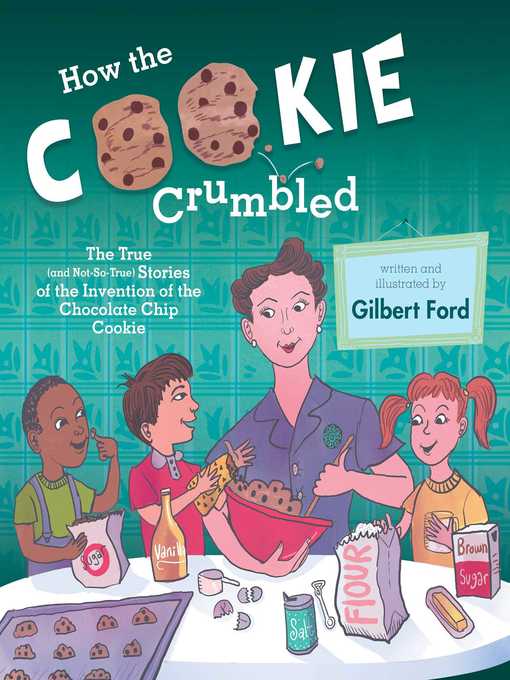How the Cookie Crumbled
The True (and Not-So-True) Stories of the Invention of the Chocolate Chip Cookie
Crunch! Crunch! Crunch!
Mmmmm!
Everyone loves chocolate chip cookies! But not everyone knows where they came from. Meet Ruth Wakefield, the talented chef and entrepreneur who started a restaurant, wrote a cookbook, and invented this delicious dessert. But just how did she do it, you ask? That's where things get messy!
So sit back and grab a cookie to read a story—or three—about how this round, crispy, chocolatey piece of perfection came to be. Which tale is true? Well, what do you think?
-
Creators
-
Publisher
-
Release date
October 24, 2017 -
Formats
-
Kindle Book
-
OverDrive Read
- ISBN: 9781481450683
- File size: 6 KB
-
-
Languages
- English
-
Levels
- ATOS Level: 4.8
- Lexile® Measure: 900
- Interest Level: K-3(LG)
- Text Difficulty: 3-5
-
Reviews
-
Kirkus
August 1, 2017
A chocolate candy bar cannonballing into a possessed mixer. Baking chocolate suddenly going AWOL. These are just a couple of the persistent myths orbiting the origins of America's quintessential dessert: the chocolate chip cookie. Thanks to Ford's kid-friendly expose, Ruth Wakefield's smarts and business savvy are revealed to be the true sources of the cookie's invention. Not only was Wakefield the chef for the Toll House Inn in Massachusetts, she also managed the restaurant. Daring to start a business with her husband just as the Great Depression hit, Wakefield's dedication to quality paid off. In 1938, wanting to change up her popular butterscotch cookie, Wakefield added bits of a Nestle's chocolate bar to the dough and--voila! From kitchens across the country to the care packages sent to homesick World War II soldiers, the chocolate chip cookie was soon everywhere. In fact, Nestle created the chocolate chip specifically for Wakefield's recipe. Ford's illustrations successfully evoke the 1930s and '40s, down to the comic-strip half-tone dot effect of the different cookie-genesis scenarios. However, Ford misses the opportunity to depict among the diners the famous personages mentioned in his author's note, and his pictorial rendition of the cookie queen is strangely unsympathetic--staff grimace behind her back as she critically frowns at their work. Quibbles aside, pastry chefs in the making will be fascinated by this accessible tribute to a true American icon and will be tempted to try the appended cookie recipe. (Picture book/biography. 5-9)COPYRIGHT(2017) Kirkus Reviews, ALL RIGHTS RESERVED.
-
Publisher's Weekly
October 9, 2017
Ford moves from the history of the Slinky (in The Marvelous Thing That Came from a Spring) to that of another American classic: the chocolate chip cookie, invented by restaurateur Ruth Wakefield. With her Toll House Chocolate Crunch Cookie a hit, Wakefield sold the recipe to Nestlé, and it remains on chocolate chip bags to this day. Using traditional and digital media, Ford paints a cheery vision of Depression-era America, highlighting Wakefield’s persistence and exacting nature (“Ruth’s staff said she was one tough cookie to work for”). He also taps into the visual language of vintage comics to present three ways Wakefield’s discovery might have come about: as an accident, substitution, or moment of inspiration. Ford casts his vote for the third option; readers will cast theirs for baking cookies from the recipe that’s included. Ages 4–8. -
Booklist
September 15, 2017
Grades K-2 It's hard to imagine life without chocolate chip cookies, but they did need to be invented, and were: by Ruth Wakefield, at her Toll House Inn, during the 1930s. No one disputes these facts, but there are some questions regarding how. Readers are presented with three possible ways the cookies might have come into existence, and encouraged to figure out which version makes the most sense. To help, this picture-book biography documents Wakefield's evolution, from child chef, to college nutrition major, to teacher, restaurant owner, master baker, and generous entrepreneur happy to share her discovery. As word spread, the Nestle Corporation was delighted with the sudden increased demand for their chocolate and started producing easy-to-use chips, delivered in the iconic bag with the recipe on the back. The mixed-media illustrations align perfectly with the breezy, pun-filled text, aptly integrating period details, expressive facial expressions, and lots of happy crunching. This will be an enjoyable choice for one-on-one or group storytimesjust be sure to have some chocolate chip cookies handy!(Reprinted with permission of Booklist, copyright 2017, American Library Association.) -
The Horn Book
January 1, 2018
This catchy title relates Ruth Wakefield's successful career as a baker and restaurateur as well as the lore surrounding how exactly her invention of the chocolate chip cookie came about; the three speculated versions of the cookies' creation make for an interesting tale. Ford's bright, cartoony illustrations' vintage aesthetic brings out the Depression-era setting. An author's note and the original recipe are appended. Bib.(Copyright 2018 by The Horn Book, Incorporated, Boston. All rights reserved.)
-
Languages
- English
Levels
- ATOS Level:4.8
- Lexile® Measure:900
- Interest Level:K-3(LG)
- Text Difficulty:3-5
Loading
Why is availability limited?
×Availability can change throughout the month based on the library's budget. You can still place a hold on the title, and your hold will be automatically filled as soon as the title is available again.
The Kindle Book format for this title is not supported on:
×- - Kindle 1
- - Kindle 2
- - Kindle 4
- - Kindle 5
- - Kindle 7
- - Kindle DX
- - Kindle Keyboard
- - Kindle Paperwhite
- - Kindle Touch
- - Kindle Voyage
Read-along ebook
×The OverDrive Read format of this ebook has professional narration that plays while you read in your browser. Learn more here.




